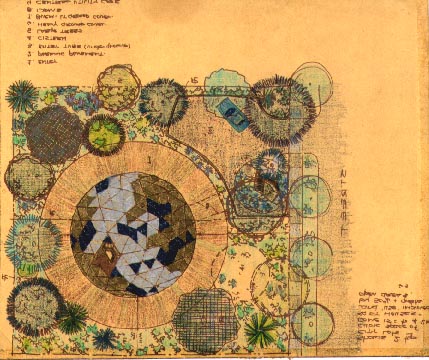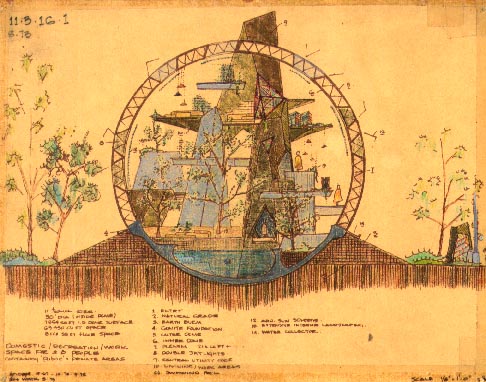| These
sketches were made during May 1973 based on a September
1967 concept. It was with these sketches that I started
to explore the “Domicile” concept in detail.
I started using the term DOMICILE in 1977. |
click on plan below to go to Domicile One |

|
|
These
sketches do not show the greenhouse indicated
on the
DomicileOne cross
section. Also, this version was for a somewhat smaller
project: about a 50 ft dome and,
therefore,
sufficient for about three families. It was conceived
as a test of the concept. I believe the design will
work
far better, economically, in the 75 foot diameter
range. On the other hand, the scale of this version
will
fit
much
better
in traditional neighborhoods populated with two and
three story houses. |
|
I
was living in an older section of Kansas City at the
time these were done and the two lots shown in the
above plot plan are about the typical size for that
area. It can be seen that the Dome, as indicated,
took up a small part of the land. A 75 foot Dome,
with earth-berm and greenhouse would somewhat crowd
a site of this size. However, a two lot layout with
one of them being at a corner would work for the larger
work which achieves much greater economic utilization.
Three lots could also be successfully employed |
|
Adjacent
to the sidewalk and just below the parking area is
the Entry/Office facility. Dotted lines indicate the
Tube to the Dome. The Entry/Office can can be seen
on the section view (right hand side) below. The detached
Office is a necessary feature of this kind of concept.
It provides a “buffer” between the inhabitants
and the outside world. Transactional relationships
do not intrude on the life within. The office area
can also include a small meeting area for casual dialog. The “business” of the Domicile can be conducted in this facility including the face-to-the-world of the self-employed inhabitants. |
|
click on drawing below to see a further development of the Entry/Office |
|

|
|
I
drew these sketches at the time I started my two
year reading binge [link: 1974].
Professionally, this was not a happy time for
me and I could find
little work that
addressed the concerns I had developed over the first 18 years of my practice. Architecture did not
seem to be focusing on, let alone solving, issues of energy use, unnecessary building
costs nor the social problems - made more intense by the time
and effort
required to earn a living to pay for the basics of
housing, energy and food - directly
related to the isolation of people from community. UpSideDown
Economics [link: aspects of upside down economics] was
flourishing. It still is. |
|
Given
this context, these sketches have an “energy”
and meaning to me far greater than just an idea for
a building - they were seeking solutions to a problem
that I felt profoundly trapped in myself: how to
secure both the time and tooling - and special interaction
- necessary to do original work while remaining free
of institutions that have their own agenda which is in opposition to your own? The work
of Jane Jacobs [link: jane jacobs] was
high on my reading list at this time and remains,
to this day, an inspiration. Jane focused
on the viability and economy of cities - what I extrapolated from
her work was the idea that the same principles
and
precepts she applied to cities can be applied to
the economy of enterprises including buildings
housing
only a few families. This is made so by the switch
to knowledge work which is inherently global and
flexible. Can a small community of families become
a “replacement economy?” I think so. |
|
Today,
we are far richer a society than 25 years ago
and
many of the problems addressed by this concept “seem,”
for many, to have gone away. This is partially true for those
who are presently capable of doing the work that
today’s economy pays highly for. Many, however,
still feel trapped and - no matter how much they
earn
- cannot seem to match work-lifestyle
with their true human desires. Few of them, however,
see how there circumstances are
tied up in the intrinsic economics of the
built-environment. And, these are the “fortunate” ones!
There are many Americans who cannot afford decent
housing
and there are millions around the world who live
in such terrible circumstances that the points being
made here would seem beyond their wildest aspirations.
The development
process [link: real real estate development] is
broken. This does not “matter”
at the high end because people can “afford”
to pay twice as much as they should for the buildings
they work [link: reworking hte workplace] and live in
and for the infrastructure they employ. No matter
the wealth we have, in the financial sense, our
present development patterns are not sustainable
for a growing population that is also becoming
more affluent. Can you imagine China and India
following the development Patterns of the USA?
Well, there are thousands of companies eager to
help them do just this [link; india china gnp]. In the end, none of this is sustainable economically not ecologically. |
|
No...
The problem has not be solved. It has not gone
away.
Great, wasted wealth accumulated by some has officiated
the issue and stolen the debate. Think about this.
At this day and age, we humans have not figured out
how to feed, educate and house our population
on a
decent level. And, we accept this condition.
We even have an economic
theory [link: upsidedown economics] that
justifies it. |
|
And,
of course, whenever the economy softens many who believed
they had “made it” discover the intrinsic
vulnerability of their situation. Stress follows,
so called assets are often lost, more self-defeating
short term decisions are made that builds more traps
for the future. A cycle repeats. |
|
The
Domicile Project explores the idea of “Urban
Homesteading” and of making the building itself
- and the social structure outside and within it -
an intrinsic and useful part of the inhabitant’s
domestic economy. There is no reason that these “domestic”
economies cannot function as “replacement economies”
as Jacobs explains them. The majority of cooperative
communities built in the United States have been done
in rural settings. Usonia Homes is an outstanding
example. These explored many of the issues that Domiciles
do. However, there is additional intrinsic value in
the Domicile concept. The “environment valve”
of the shell as an energy management system, the urban
setting close to many social and business amenities,
the efficient use of land, the “tightness”
of the community living - all add up to a formula
that many will find useful at some points along their
life cycle. As these are likely to take place at different
periods, inter-generational groups are possible. |
|
The
Domicile concept, by separating the shell from
the
interior system, provides an economical way to create
an adaptable living space that can change as requirements
change. This is the most radical aspect of the plan.
The Boulder
Affordable Housing Project
explored this same devise in a completely different
structural configuration. |
|
The
economic principles applied by these projects are:
1) never
design a systems’s overhead for peak demand;
2) find alternative ways around the peak issue.
Travel-to-work
schedules are an example that drives redundancy of
car ownership;
3) Base the design on what is best
held
as commons and what is best kept as individual tooling
and wealth. Some things are best shared with little
competition for use - others are not. These approaches
can cut tremendous redundancy and greatly lower
the
use of capital;
4) In addition, pay close attention
to energy management and the possibilities of “domestic”
food and energy production, as well as, self-provided
services. In this case, the design manages energy,
food production and their use a great deal more efficiently
than traditional domestic configurations. Certain
foods, including fish, are easily grown on site and
in the greenhouse and can provide better freshness,
quality and economy. Other items can be purchased
bulk. Only a few items are best purchased in a few-items-at-a-time
retail store. Besides costs, there are great TIME savings possible here;
5) use the free-time-capital - created by 1 through 4 - to invest in yourself and your communities creative, sustainable, life-work-style options. Create your future “by design not default.” |
|
What we are talking about here is freedom. Freedom to explore your full potential. Freedom to build communitiy around your values. Freedom to make use of what the global economy has to offer while staying free from being entrapped by it. |
|
I
estimated, in the early 70s, that the total cost
of
living for the inhabitants of a Domicile would be
half of exiting domestic architecture’s fixed overhead
while accomplishing a doubling in the quality
of
life. I believe this is an easy goal today. Think
about the implications of this. |
| Do
you know how bad modern housing is and how expensive
it is? Tie this to the cost of goods where most of
the cost to the customer is the packaging and
advertising
and you realize how very little intrinsic value is
purchased with low and middle income dollars.
Millions
literally live to work to be able to live in order
to work so they can... There is no margin in
this endless cycle. No profit [link: profit]. Profit is necessary
to improve life. Capital is required for education,
recreation, starting new ventures, transforming
a
life. Domestic economy runs by the same rules as
does a business economy however this is rarely
appreciated.
The issue of “affordable” housing is not
just one related to lower income individuals. It
effects
all economic strata. |
Boulder Affordable Housing Project:
A
large earth-shelter greenhouse glazing system
that acts like an energy environment value.
The interior is made up of societies of
approximately 125 persons each.
Each society is
composed of a number of self-organized affinity
family groups. The entire interior can be re created from a kit of parts. |
|
|
|
The AFFORDABILITY question
has to be looked at from many perspectives and levels of recursion of the Human-Earth system. Can
you afford it [link: wage slavery]?
Can our future
society afford
it [link: rebuilding the future]?
Can Nature [link: the gaia project]?
On the balance sheet of your life, what is your
housing, transportation, food supply SYSTEM costing
you and what life options are thereby precluded?
What is your domestic economy? |
|
These
studies were also related to my concept of “bootstrapping”
the social, organizational and biological systems
necessary for future space
habitats [link: bootstrap into space] by
building a series of (doubling) larger structures
that were increasingly self sufficient.
This self-sufficiency capability would also allow
Mega
Cities [link: wilderness mega city] to
be built in remote regions of the Earth, on the
ocean, in the atmosphere and, ultimately,
space. |
|
A
building should be an expression
[link: architectural criteria] of
the idea that determines its use. If a group
were to decide to live and (at least some) work
together
- how could they do this in a conventional domestic
architectural setting? There is little out there
that
serves. Certainly the typical configurations
of domestic, housing and office architecture do
not.
Several individuals and families living/working together
is a deliberate affinity group - that affinity
should be explicitly captured and augmented by the
building. Architecture must respond explicitly to
the requirements of the user not just in general
terms that forces the choice between compromise
and expensive
remodeling. Architecture has to address the systemic
issues. A “perfect” place to live and
a
“perfect” place to work do not necessarily
add up if they impose extraordinary travel times
and
social/economic compromises. |
|
EVERY
environment
should be an environment crafted for those that live
and work in it - not to some generalized model - and,
every environment should be adaptable to future
change
and use (reuse). It should be an environment
for what happens in it - now and in the future.
This is economy. It is said that this level
of fitness is too expensive. Not true if one knows
how to build [link: swimming pool/nasa methods].
It is said that everyone wants their own stand-alone
environment. When you look at the alternatives offered
- do you blame them? What if there existed an effective
definition
and practice of COMMONS?
It is said that modest living cannot be artful - WHY?
By what
definition
of architecture [link: what is architecture?] is
this asserted? It is said that general systems and
individual art are not
compatible
- what about the Usonian
Houses [link: post usonian project]? It is said that our society - the richest
in known history - cannot create a circumstance
where
basic food, education, shelter, health, access to
healthy work and living environments, cannot had for
all
it’s members - is it possible we have some design
flaws here? What true alternatives, other than subsidizing
what the market has already declared too expensive,
have we tried? |
hunter_gatherer_knowledge_based_culture |
|
Domicile
is one way of building for the modern hunter-gatherer,
knowledge-based, global culture. The Domicile becomes, in a compressed and efficient way, the landscape which supports a new kind of tribal-culture. It is one way
of overcoming some intrinsic poverty-begets-poverty
loops. It is one way to do social experiments
- on a small scale - with little attendant risk. It
is one way to LIVE without a crushing mort-gage. |
|
| The Domicile is one of many ways to employ architecture, which integrates economy and ecology, in the service of a healthy, affordable, sustainable life-style which frees people to explore their personal and group values and life quest. Modern civilization has brought many benefits to millions of people. It has also extracted a hidden cost which few are aware of yet sense in the disquiet of their lives. The final bill has yet to be tendered and when it is Humanities’ account may be overdrawn. |
| From the perspective of seven decades I can credibly assert that human life is becoming increasingly manic and un stable. Ours is a distracted society and not a happy one despite our many accomplishments and goods. The concept of leisure in it’s highest sense is nearly forgotten. Culture has become commodity. Where is civil society? It seems to be all shouting now. The nuclear family, a modern invention it should be pointed out, is in disarray. Community development is a joke. The pattern language of great cities has given away to sprawl. |
| Yet, we have an abundance of new tools and almost unlimited access to one another the riches of 10,000 years of human knowledge and culture. What is lost is time. The inventions which were to serve us have become our masters. The majority exist to feed the machine of a false modernity while the affluent turn culture into a parade of pretense and made up glamour. As Wright asked so many decades ago, When Democracy Builds, “where is the citizen?” |
| Is this the country that Jefferson dreamed? |
| Steward Brand, in The Clock of the Long Now, talks about fast and slow time and the need for both. The slow food movement seeks to bring back food, table and the art of conversation. It is critical that we rebuild the base of a civil society from the ground up. This will require a new kind of family, community, personal economy, and ways-of-living. A great variety is required and needed to match the healthy potential of our emergent species. |
| Humanity has lost awareness of itself and the situation of which it is a part. We try to control everything while losing understanding of self and community. We are wildly creative and equally destructive. It is time to rediscover living. It is time to recreate hearth and home. It is time to understand personal economy. It is time to remake the base of human life. |
|
click on drawing above to go to Design Development page |
|
| GoTo: Return of the Usonian |
|
|
|
| GoTo: A Future by Design - Not Default |
|
|
Matt
Taylor
Palo Alto
February 21, 1999 |
|

SolutionBox
voice of this document:
VISION • STRATEGY • EVALUATION
|
click on graphic for explanation of SolutionBox |
posted:
February 21, 1999
revised:
April 13, 2010
• 20000130.201420.mt • 20000205.221356.mt •
• 20011027.209876.mt • 20050210.768798.mt •
• 201004.000028.mt •
(note:
this document is about 70% finished)
|